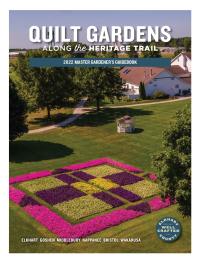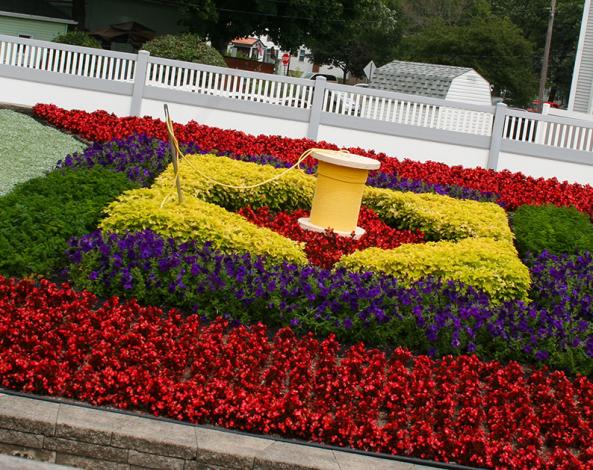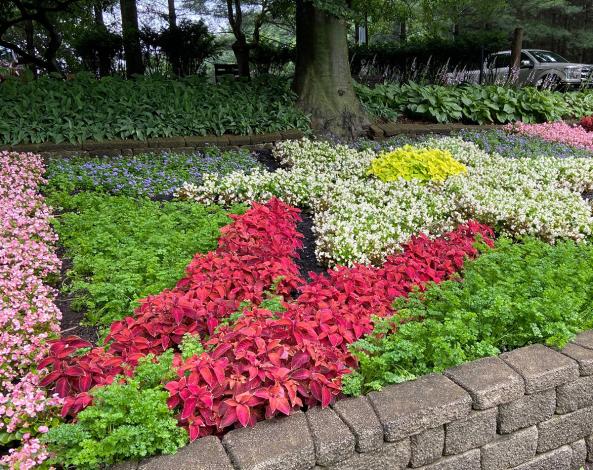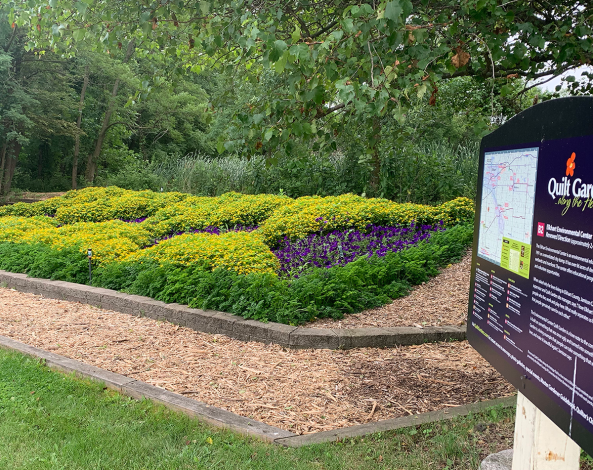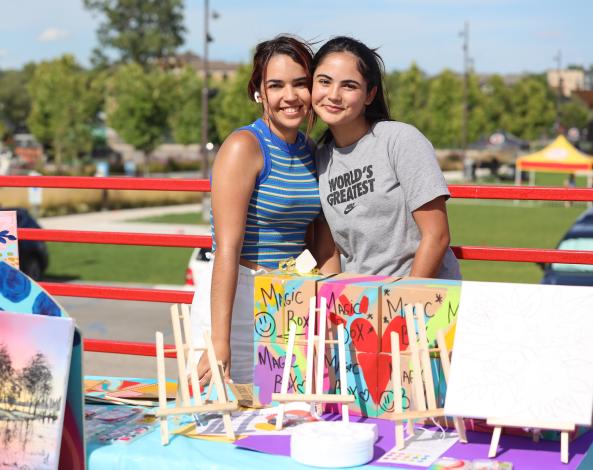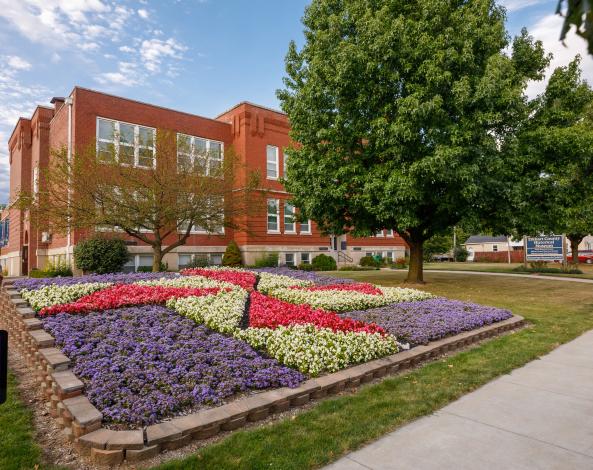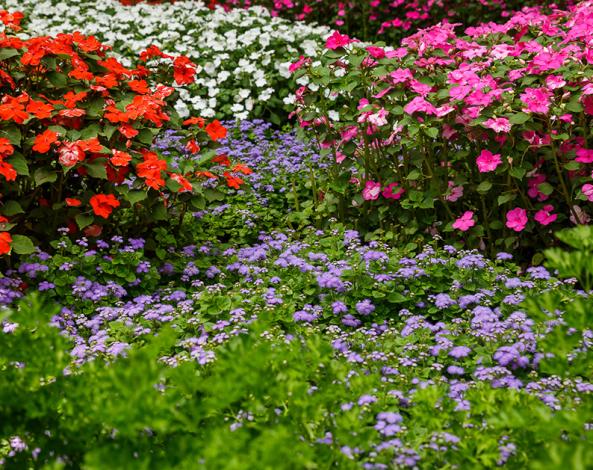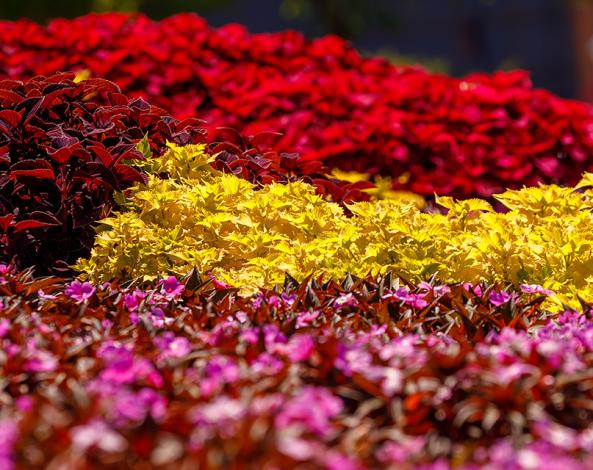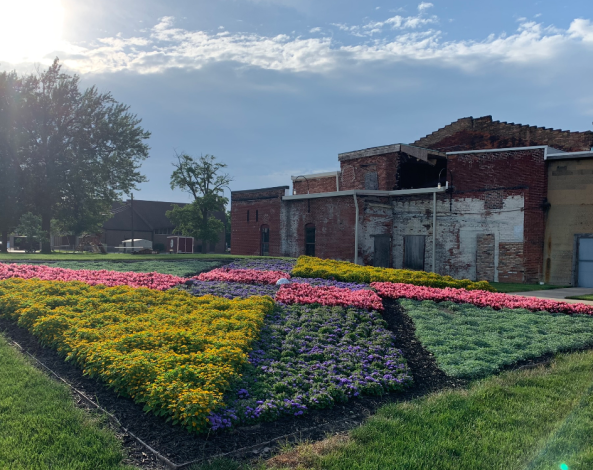About the Quilt Gardens
Quilt Gardens along the Heritage Trail is an innovative, creative, one-of-a-kind experience designed to interest a widerange of audiences and promote the area as a premier visitor destination. It offers a variety of opportunities for partnerships with local businesses and communities and creates widespread community involvement.
The project was initiated as a concept by the Elkhart County, IN CVB in early 2006 and tested in 2007 with 2 pilot locations. 2022 is the 15th anniversary for the season-long attraction that continues to grow and now features 17 Quilt Gardens presented in six communities along the Heritage Trail driving tour, viewable annually May 30 to September 15. To celebrate, world-renowned sculptor Seward Johnson’s stunningly realistic life-size bronze sculptures are coming back to Elkhart County at each Quilt Garden site.
Elkhart County, Indiana is a place where close-knit communities are connected by a passion for craftsmanship and quality of life. Everything we do in Elkhart County is Well Crafted. Recognizing the importance and value of high quality in both the gardens and murals displayed, each garden and mural is required to meet 10 standards and related product and service specifications.
Based on those standards, all official sites and patterns are juried into the program by a committee that includes landscapers, designers, horticulturists, growers, quilters, and park professionals resulting in quality craftsmanship, innovation and collaboration. Official garden partners are responsible for performing all of the work necessary to plant and maintain the gardens throughout the season.The Quilt Gardens along the Heritage Trail has garnered national media attention and draws significant audience interest from three of the largest hobby groups in the nation – gardeners, quilters and photographers. It has also been favorably received by the group motor coach audience, having been named an American Bus Association (ABA) Best of the Best Event and a seven-time Top 100 Event.
About the Gardens
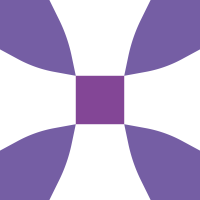
“Snowball in Summer” - Elkhart County Historical Museum
SIZE: 29’w x 29’h
Aloha Blue Ageratum
Pacifica Tattoo Blueberry Vinca
Dreams White Petunia
Visiting the Elkhart County Historical Museum Quilt Garden site gives one a chance to experience history inside and out. The museum was founded in 1968 as a partnership between the Elkhart County Historical Society and the Elkhart County Parks Department, using a building once used as Bristol High School from 1928 to 1966. The Elkhart County Historical Museum is dedicated to preserving and fostering appreciation of the history of Elkhart County and the surrounding region. The museum offers exhibits for all ages.
Today it houses 10 permanent exhibits, two additional rooms for special showings, and over 20,000 artifacts of local historical interest. Explore the past where the beautiful and the useful were never far apart. The museum is open 9 a.m. to 5 p.m. Tuesday through Saturday, although you may want to confirm prior to arrival. Admission is free, although donations are always appreciated. The Quilt Gardens generate focus and interest in the quilting heritage of the local community, which the museum is especially prepared to further celebrate. The museum has a collection of more than 60 historic quilts and offer many quilting-related programming opportunities.
The museum staff has teamed up with a group of Michiana Master Gardeners to prepare and care for Snowball in Summer. The museum staff has enjoyed working with Michiana Master Gardeners and has appreciated their knowledge and energy on this project. Knowledge is important where flowers are expected to perform at their best in a Quilt Garden year after year. Testing the pH and supplementing/adjusting the soil to create an optimum growing culture requires time and energy but yields great rewards.
Julie Parke is the museum administrator and in her fifth season working as the site manager for the Elkhart County Historical Museum’s Quilt Garden. Julie shared, “There simply is not room to have all the quilt collections on display year-round and generally the quilt exhibits take place only during the cooler months. However, this year during the Quilt Garden season, the museum is having a temporary exhibit of quilts with nature themes.” Feel free to go inside the museum to see the Nature Quilt exhibit after viewing the lovely Quilt Garden outside.
The Snowball in Summer design was chosen because it afforded their team the opportunity to branch out from prior simple geometric designs. The curves and colors raise the design and garden work to a whole new level. Julie explained the simple straight lines of a geometric design are easier to plant and maintain throughout the entire season.
Additionally, the venture into the blue and white color scheme, with Pacifica Tattoo Vinca, will provide a crisp and fresh look. Reflecting on her five seasons of experience teaming with the Master Gardeners, Julie said, “They (Master Gardeners) are such a treat to work with and we are lucky to have them. I am in awe of their knowledge, work ethic and commitment to this project.”

“Double Tulips” - Central Park
SIZE: 33’w x 33’h
Heart to Heart Burning Heart Caladium
Taishan Yellow Marigold
Celebration Electric Rose New Guinea Impatien
Gemini Blue Isotoma
Central Park adds to vibrant Elkhart County with its centralized location in downtown Elkhart. The Quilt Garden provides a colorful backdrop and adds to the ambiance for the people attending events as well as those who walk or drive by Central Park daily. With the RiverWalk close by, local walkers enjoy stopping throughout the summer to watch the flowers and pattern develop. The Civic Plaza is just above and a handy place to meet up before heading out into the growing Arts & Entertainment District with its new eateries and pubs. The beautifully renovated Lerner Theater is just up the block and offers musical and theatrical options.
Downtown Elkhart is a vibrant, diverse and unique community. The Gateway Mile features a wide variety of amenities: four museums, beautiful parks, stately homes in the Garden District, boutique shops, fabulous restaurants, cozy coffee shops, architecture, and exciting festivals. Whether you are meeting an old friend for coffee, going out for a night on the town, or looking for a family-friendly activity for the weekend, everything you want can be found along the Gateway Mile in downtown Elkhart.
This year the Central Park team selected a traditional quilt pattern, Double Tulips. I remember my grandmother making the Double Tulips quilt and hand-quilting it as only her talented fingers could do. As a little girl, I was allowed to carefully iron the pre-cut quilt pieces. Only my grandmother cut the pieces of fabric for her quilts; others need not apply!
This pattern transcends the stereotypical straight-line patterns. It is dramatic looking, with the sharp points cutting into the background color. The Central Park Quilt Garden team transitioned the pattern into a living and growing work of art, with vibrant colors. A total of 2,058 plants were used to create this energetic, exciting, electrifying design.
The lead gardener, Ric Powers, wants visitors to be aware that his team grows all their own plants from seed to starter plants, to ready-to-transplant, and final planting. The team is careful during planting and uses appropriate maintenance, care (i.e. deadheading flowers to mitigate the impact of gravity that bends the stems), and fertilizer. The Quilt Garden receives a high nitrogen fertilizer to promote new vegetation growth and increase the crop canopy. Then the team changes the feed to promote reproduction over vegetative growth. They also use a lot of Monty’s All Purpose (8-16-8) plant food in the increasing vegetative growth period of the season, with multiple applications over two weeks, switching to Monty’s Root and Bloom (2-15-15) to promote reproduction over in the third growing week and continuing regular use of the Root and Bloom for the remainder of the season at least once a week. Healthier plants are always more disease resistant. The more care given to them (deadheading and fertilization), the less likely they are to succumb to disease pressure.
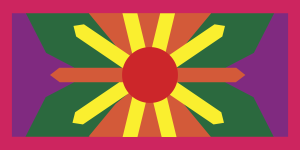
“Sunflower by Twilight” - Elkhart Environmental Center
SIZE: 52’w x 22’h
Cocktail Vodka Red Bronze Leaf Begonia
Pacifica Tattoo Blueberry Vinca
Bonanza Orange Marigold
Profusion Lemon Zinnia
Triple Curled Parsley
FotoFinish Red Petunia
The Elkhart Environmental Center (EEC), operated by the city of Elkhart, opened in 1992 as an environmental learning center that strives to educate the community on its environmental impact. The EEC is situated on the former Lusher Dump, but over the last 40 years has been remediated and restored to include more than 65 acres of enriched greenspace. The public is welcome to walk the trails and browse the gardens, woods and prairies all free of charge during open hours. There is also a canoe launch available onto the Elkhart River.
The EEC serves thousands of people a year and is committed to making the site a haven not only for residents and environmental professionals but wildlife as well. The center is part of the 120-acre River Greenway system that links to Studebaker Park along the Elkhart River. The trail is a great spot for wildlife watching on the edge of the city of Elkhart. Deer, river otter, muskrat, beaver, coyote, fox, pileated woodpeckers, screech owls and nesting wood ducks have all been sighted in this area. Bird watchers can find many migrating species as well. The trail is open to bikers and hikers.
Five wetlands have been constructed at the center, creating habitat and aiding in reducing storm water runoff. The EEC continues to blend urban and natural environment to demonstrate how they can successfully co-exist. This urban setting is a resting place to over 86 different types of birds throughout the year and is home to over 200 types of plants. Many frequent guests have said it’s the best-kept secret in Elkhart.
While visiting the Quilt Garden, feel free to explore the site and, if open, stop in at the cabin to get a history of the place. Kids will be interested in the small children’s learning loft in the cabin. Environmental centers are fun places to visit, but they are also a place where we can connect to nature, learn how to improve the environment, practice wellness, and develop new skills to help in our everyday lives.
Jeff Zavatsky, the site manager for the Elkhart Environmental Center’s Quilt Garden, states, “Last year we had many more opportunities to talk to the visitors at the Quilt Garden site. A lot of travelers who visited us were from out of state. Many were traveling in RVs. We also had a lot of ‘critters’ using the site for cover (i.e., rabbits). Curiously enough, the animals didn’t harm the plants, they just loved hanging around underneath the red coleus, with the coleus serving as shade and shelter. When we went to the garden to weed, we always had several visiting animals run out from under the plants. The dogs (maybe the deer too?) enjoyed laying in the parsley - I think perhaps it kept them cool?”
Jeff added, “We chose a special sunflower as our pattern this year. We have a lot of sunflowers and other types of flowers in our gardens, prairies and woodlands and thought it would be nice to tie the current plants and the special Quilt Garden together. We were inspired by the Bargello Sunflower with its oranges and yellows mixed with green leaves. Our garden plat is wide, so to have more pleasing dimensions for our Quilt Garden, and to provide walking paths that allow us to access the innermost areas of the garden for maintenance, without damage to the live and growing plants. Additionally, to enhance the artistry embodied in the Quilt Garden concept, we added a blue/purple background reminiscent of the magical look of the twilight sky.” Twilight is that magical time of day when a glow still pervades the air even though the sun is not above the horizon. Twilight happens twice every day, once before the sun rises as the sky is getting light, and again after sunset before the sky is truly dark. Earth’s atmosphere scatters the sun’s rays to create the colors of twilight. On planets and moons with no atmosphere such as Earth’s moon, it gets instantly dark when the sun sets.
Achieving the magical look of twilight in flowers will be a challenge to be sure. The look will require shading by blending plants, as nature blends light and the atmosphere to create a magical look. The flower petals of the fabric quilt are made from a Bargello fabric which uses five different golden yellow fabrics ranging from light to dark. The pieces are fused in place on the background just as the large flower was and stitched down with a zigzag stitch. The center of this flower is one brownish fabric and has been quilted with a grid pattern to look like seeds.
The folks at the Elkhart Environmental Center have embarked upon a very artistic challenge. We can’t wait to

“Kaleidoscope Blooms” - Linton’s Enchanted Gardens
SIZE: 50’w x 42’h
Safari Red Marigold
Bada Boom White Bronze Leaf Begonia
Sunstorm Deep Orchid Vinca
Safari Orange Marigold
Linton’s Enchanted Gardens is Indiana’s largest home and garden facility, boasting more than 50,000 square feet of indoor shopping and over nine acres of outdoor displays that are sure to spark your imagination. Linton’s Enchanted Gardens began in 1982 as a small landscape design company and has added attractions as they have grown and evolved. Their continuing goal of connecting to the community while showcasing the new and traditional in horticulture drives their business spirit. Visitors can also have their gardening questions answered as well as find new and unusual items for their home.
Linton’s has introduced parakeets to the menagerie of colorful birds at the Enchanted Gardens. A trip around the grounds on the Enchanted Gardens Railroad goes past the Quilt Garden, Lake Linton, the petting zoo, and through the tunnel to see it all. A special stop at the Parakeet Encounter House allows the riders to enter and interact with the vibrant and musical birds. Linton’s prides itself in being a family-friendly destination. Their Quilt Garden is located on the north end of the gift shop and has the advantage of an observation bridge to give guests a better vantage point for snapping the perfect picture.
Linton’s has a unique opportunity with their Quilt Garden to partner with the Vera Bradley Breast Cancer Foundation. Each year Linton’s incorporates the organization’s current Breast Cancer Awareness pattern into their Quilt Garden theme. Since 1999, Vera Bradley has designed special breast cancer awareness colors to celebrate their commitment to the cause. For their 2022 Quilt Garden, they are using the colorful Rosa Floral pattern from the Vera Bradley 2021 fall collection. The vibrant patterns of the fabric are echoed in the Quilt Garden design expressing the constant movement of the floral images with flowers that mimic the display in a kaleidoscope image.
A large portion of the garden consists of Marigolds and Begonias. The many varieties of begonias offer a range of choices for the avid gardener. Marigolds are a plant of the daisy family, typically with yellow, orange or copper-brown flowers that are widely cultivated as an ornamental.
Marigolds are very low maintenance. Once established in your garden, they need to have a few weeks of regular watering and fertilization to establish a good root system. Once the root system is mature, they will be more drought-tolerant, but they will still bloom best if given weekly water. They are notably pest-free. In fact, they are often planted as a deterrent to pests that attack other plants.
Marigolds can bloom almost non-stop and will keep going all summer until frost arrives. To achieve that non-stop flowering, keep your marigolds deadheaded. The Safari series make a superb show in garden displays with their extra-large blooms on compact plants. The red color of this plant is dark russet red. Safari Orange, like its red sister, is easy to grow and a popular annual that blooms over a long period and is great in garden beds.
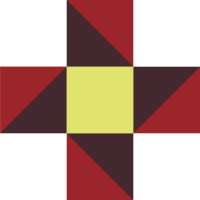
“Friendship Star” - Ruthmere Museum
SIZE: 30’w x 30’h
Snapshot Yellow Snapdragons Ipomoea Batatas
Super Olympia Red Green Leaf Begonia
Super Olympia White Green Leaf Begonia
The Ruthmere campus is made up of two historic properties that engage visitors with a unique experience of history, art and architecture. Part historic house museum, part world class art collection, part performing arts venue, such is the unique nature of Ruthmere. Ruthmere overlooks the confluence of the St. Joseph and Elkhart rivers, residing at the heart of the Beardsley Historic District neighborhood, a site on the National Register of Historic Places.
Albert Beardsley, nephew of one of the founding fathers of Elkhart, Dr. Havilah Beardsley, had Ruthmere Mansion built in 1910. The mansion is filled with lavish one-of-a-kind furnishings and stunning works of art. The magnificently restored Beaux Arts-style mansion boasts a fine art collection which includes sculptures by Auguste Rodin, Antoine-Louis Barye and William Ordway Partridge and artworks by renowned artists such as George Peter Alexander Healy, William Morris Hunt and Albert E. Sterner. Art comes in many forms at Ruthmere. The iconic greenhouse and Ruthmere’s gardens provide the perfect bridge for visitors to appreciate both the Ruthmere property and the annual Quilt Garden found just outside of Ruthmere’s perimeter wall.
The Ruthmere staff chose the traditional quilt pattern Friendship Star as it speaks to and represents the friendship between Dr. Havilah Beardsley and Chief Pierre Moran. In 1831, Dr. Beardsley, often times referred to as the “Father of Elkhart,” purchased land at the confluence of the St. Joseph and Elkhart Rivers from Chief Moran, which began the city of Elkhart and a lasting friendship. The colors of the flowers represent the four colors of mankind: black, white, yellow and red.
The center of the Ruthmere Quilt Garden is composed of Snapshot Yellow Snapdragons, a fresh spring look with strong garden performance. These bushy, low-growing plants have closely spaced, full-flower spikes in a broad range of colors. Clearly, for this garden, yellow was selected. These snapdragons would work nicely in your home garden owing to the following attributes: low maintenance, frost tolerance, attracts bees, attracts hummingbirds, fragrant flowers, just the thing to attract lots of pollinators and people to your garden. They grow 6 inches to 10 inches in height with a spread of 10 to 12 inches. You will need to fertilize them every two weeks to maintain the bushy appearance and the bright yellow color. The corner squares of this nine-square design are white, as in Super Olympia White Green Leaf Begonias, and one-half of the cross-piece squares are Super Olympia Red-Green Leaf Begonia, while the other half of those squares are black.

“New Crossing” - Southgate
SIZE: 32’w x 32’h
Cocktail Vodka Red Bronze Leaf Begonia
Super Olympia White Green Leaf Begonia
Triple Curled Parsley
The big red barn called Southgate was built by Amish craftsmen using the old-world tradition of joining mortis and tenon joints with wooden pegs. It is one of the largest Amish-built peg and beam barns in the nation and is a beautiful and unique cultural landmark in Elkhart County. Southgate houses a variety of small businesses making it the perfect shopping destination for unique, locally made, hand-crafted and antique items along with a variety of food options and event space. Not only is Southgate a cross-section of many businesses and artisans, but it also hosts activities and events. Given all of this, the New Crossing quilt design is a perfect choice for their return to the Quilt Garden project.
The new owners of Southgate are excited to be part of the 2022 Quilt Garden season. According to Mike DeCola, the Southgate site manager, “The reason for the pattern choice was simply because we believe it will look nice and be a great complement to our property.” The Quilt Garden will come to life with Cocktail Vodka Red Bronze and Super White Green Leaf Begonia along with Triple Curled Parsley.

“Fresh Connections” - Wellfield Botanic Gardens
SIZE: 30’w x 30’h
Eureka White Green Leaf Begonia
Profusion Lemon Zinnia
Easy Wave Lavendar Sky Blue Petunia
Profusion Cherry Bi-Color Zinnia
Profusion Orange Zinnia
Profusion Red Zinnia
Founded by the Elkhart Rotary Club in 2005, Wellfield Botanic Gardens’ purpose is integral to both the quality of life and authenticity of place. Wellfield’s mission is to promote the inseparable relationship between water, plants and animals, inspire creativity and education while celebrating nature, foster stewardship for the natural world, and bring people together to build community. More than 36 acres in size, half of which are water, Wellfield resides on a historical piece of property originally known as the North Main Street Well Field. The property has been a source of hydraulic energy and drinking water for the city of Elkhart since the mid-1800s and continues to provide most of the drinking water for the community.
Wellfield’s Quilt Garden is located just outside its gates, where it is showcased in a stone-lined bed. After visiting the Quilt Garden, buy a ticket and step inside Wellfield to get in touch with nature as visitors stroll winding paths dotted with charming pump houses and whimsical sculptures. Vantage points from walkways and bridges offer panoramic views while shaded benches invite quiet reflection. As a botanic garden, every day is different throughout the seasons and Wellfield’s diverse and interesting garden spaces make it a special place to visit. An admission fee is charged for entering the gardens, but you do not need to enter to view the Quilt Garden. Visit Wellfield’s website for more details.
Wellfield Botanic Gardens is a natural fit to feature a living Quilt Garden as it is a chance to showcase horticultural experience and provide an aesthetic addition to the Heritage Trail. The theme for Wellfield Botanic Gardens for 2022 is Year of Connections. The site manager for Wellfield’s Quilt Garden, Amy Myers, shared, “After I did an online search, I found a quilt pattern named Fresh Connections. This design seemed perfect for our Wellfield Quilt Garden design this year as it is a fun and colorful pattern that fits wonderfully with our overall theme and our desire to connect and communicate with our community and beyond.”

“Towering of Gifts” - Abshire Park
SIZE: 31’w x 31’h
Pink Passion Easy Wave Petunia
Frost Blue Petunia
Madness White Petunia
Red Hot Sally Salvia
Aptenia Maya
The Quilt Garden located in Abshire Park is a place where people gather. Donated to the Goshen Parks and Recreation Department in 1986, this is the third largest park in the city, spanning 75.5 acres. Abshire Park helps to maintain balance in the park system between active and passive recreational opportunities. The park provides access to the adjacent Pumpkinvine Nature Trail, a leg of the Maple City Greenway trail network. Abshire Park offers a beautiful trailhead and ample parking for the abundance of trail enthusiasts this park attracts. The north end of the park is a managed natural area and includes a prairie restoration, wetlands and traditional forest. Rock Run Creek borders the park to the southwest. The many different landscapes that come together in Abshire Park provide an ideal habitat for animals and birds. Abshire Cabin, a rentable enclosed pavilion, is located on the property.
You might wonder why so many businesses and organizations participate in the Quilt Garden project which takes a great deal of time, commitment, labor hours in planting, and the hard work of ongoing maintenance? Frank Shula, site manager for the Abshire Park Quilt Garden, explains it best, “Everyone admires the Quilt Gardens. They seem to smile in appreciation, which makes it all worth it.” For visitors, the joy of seeing the Quilt Gardens comes through in smiles on their faces.
Abshire Park joined the Quilt Gardens in 2019. This year the unique quilt pattern selected is the traditional quilt pattern Towering Gifts, although the name has been slightly altered to Towering of Gifts. The team selected this pattern due to its uniqueness.
The Quilt Garden is located just down the sloped path from the parking lot, which allows visitors to get an excellent view of the flowers that create the Towering of Gifts. The position of this garden is showered with full sun.

“Head, Heart, Hands and Health” - Elkhart County 4-H Fairgrounds
SIZE: 20’w x 40’h
High Tide Ageratum
Gay’s Delight Coleus
Triple Curled Parsley
Olympia Super White Green Leaf Begonia
Cocktail Brandy Pink Bronze Leaf Begonia
Cocktail Vodka Red Bronze Leaf Begonia
Olympia Super Rose Green Leaf Begonia
The Elkhart County 4-H Fairgrounds is a busy place year-round with RV, motorhome and motorcycle rallies, weddings and receptions, plus corporate and community events. The Elkhart County 4-H Fair is one of the largest 4-H county fairs in the nation, with more than 200,000 attending the nine-day event, scheduled for July 22-30, 2022.
One of the first things that impresses many about the fair is the fairgrounds’ landscaping. The entrance to the Elkhart County 4-H Fairgrounds is beautifully landscaped with flowers and shrubbery. The landscaping doesn’t end at the entrance. Most of the buildings throughout the fairgrounds are landscaped with colorful flowers and nicely manicured shrubs, so the Quilt Garden is just one of many photo ops while at the fairgrounds.
This garden is a cooperative partnership between four organizations: Purdue University Co-operative Extension Service, Michiana Master Gardeners Association, Elkhart County Extension Homemakers, and the Elkhart County 4-H Fair Board. While planting and maintenance are primarily done by the Master Gardeners, the Extension Homemakers help and have contributed to the design. All four organizations help with expenses. Each group brings knowledgeable and generous individuals committed to the mission of the project.
The Quilt Gardens at the Elkhart County Fairgrounds have varied greatly over the years, but they always include green to represent life and agriculture. Len Harms, the Fairgrounds Quilt Garden site manager and lead gardener, states, “Our Quilt Garden is a reflection of the power of youth and the positive power of 4-H on all who make it a part of their life.” In 2022, they are using a pattern previously used at the Fairgrounds in 2014. The motto of 4-H is “To Make the Best Better.”The Quilt Garden team intends to do just that. Len goes on to say, “We will take what has come before and work to make it better. A clover is most appropriate for the strong 4-H logo of head, heart, hands and health.”
The four acres of the Elkhart County 4-H Fairgrounds complex are sacred ground for those connected with the 4-H program. Every year, Elkhart County 4-Hers are recognized for their ingenuity, hard work, interest in living a healthy lifestyle, and commitment to service to their club, community and world.
The Quilt Gardens team here chose a color palette that radiates exuberance much like that demonstrated by the young people who actively participate in 4-H and are guided by trained and dedicated 4-H leaders to “learn through doing, as well as learning through responsibility.” Shortly after joining 4-H, young people are taught to conduct their own meetings using Robert’s Rules of Order as their guidebook to navigate respectful discussions during human interactions. 4-H provides annual training in the proper way to conduct meetings and come to consensus decisions. You can tell when an adult is highly skilled at leading a meeting or guiding diverse sides of an argument to a consensus; it is highly likely that they began learning those skills as young as 10 years of age in their 4-H club.
The 4-H program has been green since 1902, which is why 4-Hers say, “I bleed green!” 4-H becomes part of their DNA and has a hand in making them who they are as adults. Think about this as you enjoy their 2022 Quilt Garden and study the commitment that brought this together.
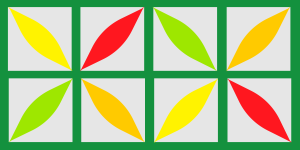
“Joseph’s Coat” - Elkhart County Courthouse
SIZE: 20’w x 40’h
Lime Delight Coleus
Bonanza Orange Marigold
Ruby Slipper Coleus
Bonanza Yellow Marigold
Silver Falls Dichondra
In an area once inhabited by the Miami and Algonquin Native Americans, Goshen was established in 1831 and is the Elkhart County seat. Today you can find testimony to the indigenous in street and park names around the city. Goshen is fast becoming a center for cultural and visual arts all revolving around an historic downtown which embraces its past. Few towns Goshen’s size (just over 34,000 residents) can boast a thriving downtown cultural arts scene, beautiful historic architecture and intriguing places to eat and shop.
Because of its central location, the courthouse is a good place to park and explore downtown. It is within easy walking distance of many unique locally owned shops and eateries and the Goshen Historical Museum. Looking at the skyline one can see testament to the good bones of a historic town. The courthouse building, over 100 years old in the Renaissance Revival style, is stately and the magnificent Neptune Fountain adds to the ambiance.
Perhaps one of Goshen’s greatest boons is its bounty of independent restaurants. Foodies need look no further than downtown for artisan pizza and bread, craft beer, chocolates, burritos, gelato and spicy curries. The city is also home to five artists’ guilds and several galleries and shops dot the downtown and surrounding area showcasing artists’ work.
In the Bible, Joseph’s Coat was a source of envy. Just like the Coat of Many Colors, many will envy the beauty of this very old quilt design and there are dozens of variations on the original theme. In addition to the straight lines of the squares containing the petals, the lovely, gentle curves of the petals add a soft elegance to the pattern.
The site manager for the Courthouse Quilt Garden, Kirt Hunsberger, says of this choice, “We thought this design could be duplicated nicely in a rectangle garden.” Regarding care and maintenance of last year’s garden, Kirt shared, “We had lots of grass for some unknown reason in our soil, requiring five people 1.5 hours each or over five hours of the team’s time every week to pull the grass from the garden to ensure the integrity of our design. We will work on reducing grass for 2022 Quilt Garden.”This is a valuable and important lesson shared by Kirt regarding your home gardens. The quality of your soil is the foundation for your growing and nurturing success.
The Courthouse team is using Bonanza Marigolds. These double-crested flowers are the largest of any marigolds of this type. In the landscape, the plants are excellent performers under a wide range of conditions. This series produces robust 2-inch blooms on compact plants. While manageable in the pack, the Bonanza vigor translates to superb free-flowering and excellent performance in your garden. This series (Bonanza) would be a good bet for you to try in your home garden.

“Fractured Four Patch” - Old Bag Factory
SIZE: 32’w x 32’h
Aloha Blue Ageratum
Olympia Super Rose Green Leaf Begonia
Cora Cascade White Vinca
In 1896, J.J. Burns opened the Cosmo Buttermilk Soap Co. in Goshen. The production building, constructed expressly to facilitate Burns’ new business, took up nearly 80,000 square feet of space. Inside, workers manufactured laundry soap, fine bathing soap and toilet paper. In 1910, the plant was renovated and purchased by The Chicago-Detroit Bag Co. A 1924 merger put the building under the control of the Chase Bag Factory and became part of a colossal enterprise. The Goshen plant was one of the largest and most important of the 15 plants owned by the company. The range of bags extended from waterproof burlap sacks to the fine, sheer paper used in Hershey’s Kiss wrappers. The term “bagology” which is painted across the building was coined during this period, meaning “to elevate the production of bags to the level of science.”
In 1984, the Old Bag Factory was restored, and artists and merchants began making this nostalgic building and its surroundings their home. The Old Bag Factory thrives on craft and commerce just as it had in the past. One can watch hand-thrown pottery being processed while strolling on original wood floors or see locally crafted Amish-made furniture on display inside this impressive historic structure. Now, instead of transporting goods by train, the Old Bag Factory’s artists and merchants can send their crafts away in - what else? - shopping bags.
The Old Bag Factory has chosen to cut away panels of sod to form a permanent template for use each year. This is one way they create a path from which to care for the flowers, but it also requires continual vigilance to keep the openings neatly edged and to size.
Loranna Schlabach, the site manager for the Old Bag Factory’s Quilt Garden, states that the primary reason for selecting the Fractured Four Patch design to bring to life this year was the simplicity of the pattern. Loranna is new to the Old Bag Factory team and is very excited about participating in the Quilt Garden project with her team. When a team is planting 1,024 square feet with almost 2,000 plants and grass, it is a smart idea to go back to that old saying we learned as children, namely “K.I.S.S.” (keep it simple, stupid.) Better to have a very well-done simple garden than to do a poor job on a very complicated garden design.

“Diamond in the Square” - Das Dutchman Essenhaus
SIZE: 54’w x 61’h
Hawaii Blue Ageratum
Eureka Green Leaf Rose Begonia
Easy Wave Pink Petunia
Evolution White Salvia
Since 1971, Das Dutchman Essenhaus has been dedicated to providing each guest with a wholesome, safe environment, warm hospitality, outstanding service, and consistent quality. What began as a 120-seat family-style restaurant has grown to become Indiana’s largest restaurant with over 1,100 seats. In addition, the campus offers overnight lodging at the charming inn, shopping opportunities in boutique-style stores, a home-style bakery, and abundant outdoor recreational options. The Essenhaus has been a part of the Quilt Garden project since its inception and states that “creating a large-scale quilt pattern of living flowers is special and unique in our ‘patchwork community’ and we’re thrilled to have the opportunity to participate.”
The company’s mission extends to every corner of the grounds, including this lovely floral Quilt Garden covering about 3,300 square feet. As the site of one of the first two test gardens in 2006, the Essenhaus continues to offer their best to the Quilt Gardens along the Heritage Trail. Keeping a Quilt Garden vibrant takes plenty of time and water.
However, there is such a thing as too much water. Last season, the Essenhaus team dealt with weather extremes: heat, humidity, long periods of endless rain followed by long stretches of no rain, as well as bad storms. Jamie Swick, site manager for the Essenhaus Quilt Garden, expressed her frustration with the weather issues in 2021, “It seems as if Mother Nature has gotten very dramatic. I have seen and dealt with so many issues last season that the level of problem-solving was an experience I have never had before.” She hopes that this season will see milder and more consistent weather.
Jamie tells us, “We selected this pattern because of its simplicity. After reviewing our previous pattern selections and looking at everyone else’s choices, I have come to the conclusion that more simple patterns with a limited number of varieties of flowers will be easier to install and maintain but also look much nicer in the long term. I would like to inspire our visitors to want to garden and not to overwhelm them with the complexity of a pattern.”We can all learn a lot from Jamie’s observation - that there is value in simplicity.
The begonia (Eureka Green Leaf), used here in a rose color, offers a clean, compact and uniform look. Its extensive basal branching, meaning deep- or early-branching, translates to excellent outdoor performance and a free-flowering habit, meaning it generally blooms for the entire season. These plants bloom early and perform equally well in garden beds, mixed containers and hanging baskets. You will find that it continues to bloom in hot, humid conditions, is drought tolerant, rabbit resistant, heat tolerant, shade tolerant, and low maintenance. What more could a gardener ask?

“Double Windmill” - Dutch Country Market
SIZE: 45’w x 45’h
Vista Bubble Gum Supertunia
Black Cherry Supertunia
Vista Paradise Supertunia
Triple Curled Parsley
Super Olympia White Green Leaf Begonia
Situated in real Dutch country, Dutch Country Market provides a chance to stop and listen to the bees a-buzz in the garden. You’ll find the huge (2,210 square feet) Double Windmill Quilt Garden full of flowers as well as bees. In fact, bees and other insects seem to appreciate the Quilt Gardens just as much as the visitors. Pollinators can often be seen nestled among each of the 17 Quilt Gardens in Elkhart County, and site managers such as Norman and Katie Lehman are careful to avoid harmful pesticides and to use natural fertilizers so the bees stay healthy and productive, and with good reason.
Honey is one of the Lehmans’ specialties. Norman has tended bees for more than 20 years and produces 36,000 pounds of honey products a year! The pure honey you find here is all from their own beehives as well as beekeeper friends throughout Indiana. Ten flavors of spun honey as well as peanut-butter-n-honey spread are made right there, much to the delight of customers. Dutch Country Market carries jars of honey in many sizes and varieties, comb honey, honey sticks, bee pollen, beeswax candles and soap, and nine flavors of whipped honey. They also have a working honeybee hive right inside the store where you can see the bees at work. They love to send customers out with, “Have a honey of a day!”
Dutch Country Market is also the home of Katie’s homemade noodles, where you may observe noodles being made daily right before your eyes. In 2005, Norman and Katie used Katie’s homemade noodles to launch the market. As the business has grown, so has the selection of noodles - four widths, two thicknesses, white and whole wheat, and an average of 400 pounds a day - all made from scratch with no preservatives. On weekday mornings customers can watch them rolling out the noodles. They also have a wide selection of other products such as jellies, pickles, preserves, salty snacks, and another local favorite, Amish peanut butter. Outside, local produce of amazingly high quality can be found in season, as well as locally made lawn furniture.
Homeland Gardens, an Amish grower in Middlebury, works with Norman and Katie each fall to select the next year’s plants for their Quilt Garden. Norman loves to look through seed catalogs and get the local growers’ expert advice on plant variety, color and growing habits. Homeland Gardens owners Paul and Barb Schwartz also grow the Quilt Garden plants for

“Fireworks” - Krider World’s Fair Garden
SIZE: 20’w x 40’h
New Look Dusty Miller
Red Cocktail Bronze Leaf Begonia
Aloha Blue Ageratum
The history and beauty of Krider World’s Fair Garden, managed by the Middlebury Parks Department, adds to the Quilt Garden experience. Not only are visitors able to see a beautiful Quilt Garden, but they also learn about the Krider family history and enjoy the pleasant park and botanical garden atmosphere. The current garden serves as a historical and botanical icon to the Krider Family Nursery. It was formed by Vernon Krider in the late 1800s and was known as the largest plant nursery between Cleveland and Chicago.
The gardens were originally designed for display in the 1933-1934 Chicago World’s Fair. The Krider garden then began as display gardens for the nursery after bringing back many of the structures from the World’s Fair exhibit. The nursery was an important and meaningful business for the town of Middlebury. It once was the largest employer for the local economy and was a major reason the Pumpkinvine railroad was built through Middlebury.
While strolling through the gardens, one can find a multitude of photo ops among the structures. The concrete mushrooms from the 1933 Chicago World’s Fair are a great photo spot, as are the windmill, water features and gazebo where one can also sit in the gliders and rest a while.
The 2022 Krider World’s Fair Quilt Garden is a stylized version of the traditional Fireworks quilt pattern, here interpreted in Bronze-leafed Red Begonias, Dusty Miller and Ageratum, to salute and celebrate the American family in flowers. Metal stars, painted gold, are attached to posts that are anchored in the ground. These stars stick up around 2 feet from the ground.
The Fireworks Quilt Garden is inspired by the Middlebury families who continue to love and support Krider World’s Fair Garden, by the Middlebury Parks Department that maintains and cares for it, and by the visitors from all over the world who enjoy the simple pleasure of walking its wood-chipped paths. Nature can bring us all together as one big family.

“Nature’s Stained Glass ” - Nappanee Center & Chamber of Commerce
SIZE: 30’w x 30’h
Bonanza Orange Marigold
onanza Yellow Marigold
Easy Wave Lavender Sky Petunia
Aloha Blue Ageratum
Midnight Madness Petunia
Triple Curled Parsley
Red Hot Sally Salvia
Nappanee sits at the crossroads of U.S. 6 and S.R. 19, two major highways in the northern sector of Indiana. It’s a community of people that thrives on being tight-knit. From the construction of the downtown pavilion completed through a community effort that resembled an old-fashioned barn raising, to city employees who strive to provide the best possible government services to its residents and guests, the city lives “community.”
The quarter-block area of the Quilt Garden is adjacent to the Heritage Trail and in the backyard of the Nappanee Chamber of Commerce and Nappanee Center Museum. The chamber shares space with the Nappanee Center/Heritage Museum and the John Hartman Home, a structure that dates to 1897. The Heritage Museum has an impressive collection started by former librarian Evelyn Culp in the Nappanee Public Library but later moved to this site. Over the years this collection has expanded to include a collection of historic Hoosier cabinets, the new Emma Schrock art exhibit, a cartoon artist collection, and many other items of interest.
Sandra Witt, site manager for the Nappanee Center’s Quilt Garden, shared, “Originally, we chose our pattern by popular vote, but doing some research we discovered that Nappanee actually had a stained glass company, Lamb Brothers and Green. The business was founded around 1901 to the late 1920s. Unfortunately, they did not survive the Great Depression. They created stained-glass lamps and stained-glass windows; their work was often mistaken for Tiffany lamps. The Hartman house and the Nappanee Museum still house two of their table lamps, four stained-glass windows, a chandelier, and a sconce from the company and they’re on display for viewing. Many homes in Nappanee still have Lamb Brothers and Green lamps with stained glass in them.”
The selection of colors for this Quilt Garden truly gives the look of stained glass. The red(Red Salvia), orange (Orange Marigold) and yellow (Yellow Marigold) are bright and beautiful. The blue (Midnight Madness Petunia) and purple (Lavender Sky Petunia and Aloha Blue Ageratum) provide an excellent, distinct framework for the colorful center of this garden pattern. The green is Curly Parsley. And the black lines are Black Mulch walkways to allow for maintenance such as weeding. The black lines are reminiscent of the round lead cane that holds the pieces of glass together and is used to create classical stained-glass windows.
No matter what you choose to plant, one of the keys to a successful garden is getting plants off to a good start at planting time. First, be sure to match the plant to the planting location. For example, if a plant prefers full sun, select a spot that gets at least six hours of sun each day. It’s important to plant properly, too. Carefully follow instructions for planting bare-root and
pre-potted plants. If you are planting from seeds, give the seeds a good deal of attention, water, and light for a healthy beginning. A good start will help you be more successful throughout the growing season.
To keep all the Quilt Gardens looking like quilts requires work, not only in regular maintenance such as watering, weeding and fertilizing, but also with deadheading, pinching and trimming in order to see the quilt pattern. Quilt Gardens are a labor of love by the many who work (often as volunteers) to make them perform well and look their best all summer long.

“Rail Fence Flag” - The FarmHouse Inn B&B
SIZE: 20’w x 40’h
Victoria Blue Salvia
Olympia Super White Green Leaf Begonia
Cocktail Vodka Red Bronze Leaf Begonia
The FarmHouse Inn B&B was originally built in 1840 by Christian Stahly, an Amish pioneer farmer from Wayne County Ohio. The Stahly’s were some of the first settlers to Nappanee, which was established in 1874, and even built the historic farm across town which offers guided tours. The barn behind this Quilt Garden echoes with a history of its own as many of the surrounding Amish families once attended church here.
By the turn of the 20th century this home had acquired the name “Buffalo Farm” during a time when the bison were characteristic of the area. That history was
celebrated in 1993 when The Olde Buffalo Inn B&B opened in the expanded and restored property. Today, the original farmhouse still exists and once again welcomes guests to a relaxing and cozy Bed and Breakfast operated by current owners Kenton and Emily Hostetler who purchased the home in 2020. In addition to lodging, they also offer tour, meal and theatre packages with their cross-town friends at The Barns in Nappanee. At isitElkhartCounty.com/plan/deals-discounts/ you can see these packages plus more deals and discounts throughout Elkhart County.
The quilt pattern here is the Rail Fence Flag quilt design and is a variation on a rail fence quilt pattern featuring a patriotic design in front of the historic barn.
It’s exciting but still shows crisp, clean, big, bright, and bold blocks of patriotic colors, to lift the soul of any American in this rural and relaxing setting.
The field of blue is created with Victoria Blue Salvia. Salvia is a compact, well-branched annual that produces abundant spikes loaded with large blue flowers
over a long growing season. Plant Salvia in full sun and well-drained soil.
For perennial varieties in Zones 5 and colder, drainage is especially important in winter. Cut back hard, to 3-4” after flowering to keep plants compact and to promote rebloom. The red in the flag pattern is Cocktail Vodka Red Bronze Leaf Begonia and the white is Olympia Super White Green Leaf Begonia.
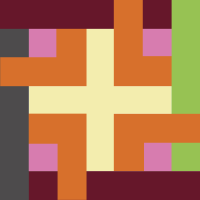
“Woven Knot” - Downtown Wakarusa
SIZE: 30’w x 30’h
Super Olympia Red Green Leaf Begonia
Bonanza Flame French Marigold
Cocktail Whiskey White
Bronze Leaf Begonia
Strawberry Blonde French Marigold
Vanilla Marigold
Wizard Jade Coleus
Wizard Scarlet Coleus
Wakarusa is one of those towns where the rush of the big city is left behind and old-fashioned is an honored trait. Centered around the town’s only stoplight, you can find historic buildings featuring tin ceilings, a hardware store open since 1904 with a wall of 1,000 drawers ready to serve you, and a dime store. The Wakarusa Dime Store was begun by a German immigrant in 1907 as Wolfberg’s Department Store. Today, the Wakarusa Dime Store is home to the Giant Jumbo Jelly Bean, plus over 450 varieties of retro, classic and popular candies!
The Wakarusa Quilt Garden continues to bring people from all over to participate in this great adventure of loving and enjoying nature. Local residents and travelers from out-of-state agree that the Wakarusa Quilt Garden was worth the trip from near or far to view. The Woven Knot pattern was selected for this year’s Quilt Garden. This will be a different, more geometric design than previous choices that have been primarily flower designs. This pattern gives more options for color choices with the potential to use up to seven colors and types of flowers. To add to the coordination of color, this color scheme will be incorporated throughout the town of Wakarusa in their downtown hanging flower baskets.
To bring the Woven Knot Quilt Garden to life required more than 3,000 flowers as well as brown mulch for the walkways. These walkways are an important part of the living design, as they provide easy access to maintain the garden without damage to the flowers.
Sonya L. Nash, Project Manager, Elkhart County, IN CVB
It is often times said that creating anything worthwhile takes time, money and a lot of effort. The Quilt Gardens along the Heritage Trail embodies that statement, even more so in these times that continue to be affected by the coronavirus pandemic.
In 2022, this project continues on supported by the devotion and pride of both the Elkhart County, IN CVB and its community partners. This project means a great deal to all of us, for the beauty it offers to all who visit but also the community pride that is expressed in every square inch of the gardens. Our partners contribute more than 200 volunteers in six cities and towns. They work on soil content, site beautification, planting, weeding and maintaining gardens for four months, sometimes during difficult weather conditions, doing their part in welcoming visitors and residents alike.
The Elkhart County, IN CVB leadership and staff supports these dedicated volunteers, working year-round on planning, preparing and promoting the Quilt Gardens. Countless man hours including graphic design, website updates, ad placements, journalist inquiries, group tour planning, and yes, even paying the bills and answering the phones all occur under the parameters of the Elkhart County, IN CVB. Through our collective efforts, the Quilt Gardens offer a beautiful and serene refuge.
My role is to keep everyone working together on the same page while steering this project in a positive future direction. For over 15 years, we have learned through trial and error a multitude of things about transforming quilt designs into living gardens that flourish throughout the viewing season. Educational sessions, working with garden experts and experimenting with plant types are all part of the event too. While gardening can be a science, we have learned that sometimes Mother Nature overrules our efforts to excel, and sometimes we are amazed at how our plans come to fruition in a fantastic way.
Yes, the Quilt Gardens project is a work of art. It’s also A LOT of work involving A LOT of people. It has become an annual event in our destination that our residents love to share with visitors. Definitely it’s time, money and effort well spent and enjoyed by all. We look forward to your visit and hope you return time and time again as we continue to learn and grow along with our gardens.
About the Author
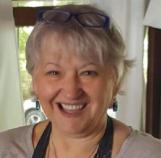
Dr. Lois D. Wiley Anderson, Ph.D.
Silver Level Master Gardener
I was born and raised in Frankfort, Indiana. As a young child, it was common for me to wander into our very large food-producing garden and break off a long piece of rhubarb. I would place the broken end of the vibrant pink stalk in my mouth and enjoy the wonderful sour taste. As I write this, my lips are puckering and saliva has begun to flow profusely. My experience with rhubarb straight from the garden is my earliest garden memory.
Frankfort is the county seat of Clinton County, a county that embraces 4-H. When I was a few months from turning 10, I asked my parents to let me sign up for 4-H. Back then there was no mini-4-H. The 4-H extension agent saw how excited I was and allowed me to sign up early. I loved 4-H and gardening was one of my chosen areas of study. I learned so much from 4-H activities. I have often said that I am a product of 4-H. Once a 4-Her, always a 4-Her.
To become a Master Gardener was a logical progression for me, but my work did not afford me the time to take the training, which was only offered workdays in the daytime. Once I retired, I signed up for and completed the training in 2018. My experiences with the Master Gardeners Association have been varied and provided much growth in my gardening knowledge. I am an active member of the organization, helping with Garden Expo, Garden Tour, speaker’s bureau, AG Hall hostess and demonstrations on a variety of topics during the Elkhart County 4-H Fair, tree sale, answer line, and now — the Quilt Gardens. Our motto is “Helping Others Grow.” I embrace that motto as my own.
About the Grower
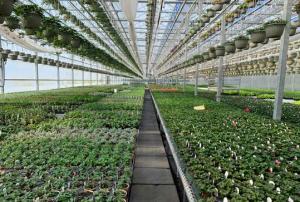
Corstange Greenhouse, Official Grower Dave, Ilene and Todd Corstange, Owners
In 1971, on property purchased from his grandfather, Dave Corstange built several small greenhouses in Portage, Michigan. Now in its 49th season, Corstange Greenhouses are operated by the family team of Dave, his wife, Ilene, and their son, Todd. The attributes which set this family of growers apart are their commitment to quality, service and customer satisfaction.
The Corstange Greenhouses provides the best quality product possible by allowing their plants to easily grow to their natural size and beauty. This goal is achieved by appropriate selection of containers and soil, careful timing of fertilizer and pesticide application, and minimal use of plant-growth regulators. This process produces high-quality plants with some residual nutrients and pest resistance, yet no residual growth retardant.
The Quilt Gardens along the Heritage Trail is an exciting project for this family-owned greenhouse and the Corstanges look forward to seeing their superior plants add to the beauty of the project.
Corstange Greenhouses
1749 E. Centre Ave. | Portage, MI P: 269.323.1094
W: CorstangeGreenHouses.com
A look back at the 2023 Quilt Gardens
-
Enjoy Elkhart County Gardens
Enjoy the spring splendor of blooming flowers, lush landscapes and fragrant atmosphere throughout Elkhart...
-
Quilt Gardens Fun Facts
- Free and open to the public annually May 30 - September 15. - The Quilt Gardens started in 2007 with two...
-
Quilt Gardens in Elkhart County
May 30 - September 15 The Quilt Gardens along the Heritage Trail joins quilting, gardening, and art into a...
-
Quilt Gardens Locations
The Quilt Gardens joins quilting, gardening, and art into a one-of-a-kind, free event featuring more than a...
-
Summer Fun in Elkhart County
Great concerts, mouth-watering food, amazing artwork, live theatre, unforgettable experiences make summertime...
-
Free Things to Do in Elkhart County
Fun doesn’t have to come with dollar signs attached. The Heritage Trail Driving Tour is proof of that!...
-
7 Things You Didn't Know About the...
May 30 - September 15, annually Quilt Gardens ...along the Heritage Trail. gigantic gardens, and hand-painted,...
-
Your Guide to the Quilt Gardens...
Overview The Quilt Gardens...along the Heritage Trail joins quilting, gardening, and art into a one-of-a-kind...
-
Six Free Things to Do Along the...
Fun doesn’t have to come with dollar signs attached. The Heritage Trail driving tour is proof of that!...
Is there a map of the Quilt Gardens and Quilt Murals?
Yes, here is a map that shows the Quilt Gardens and Quilt Murals locations, names, and location address.
If you would prefer a quick list of the Quilt Gardens and Murals addresses click here.
Quilt Gardens MapWhen can I see the Quilt Gardens?
The Quilt Gardens are viewable May 30 - September 15 each year during all daylight hours. Elkhart County is on Eastern Standard Time which means in summer time, daylight can mean perfect garden enjoyment as late as 8 or 9 p.m. each evening. Many people like to go back to their favorite site to see them at different light and times of the day.
Learn more about the quilt gardens.Are the Quilt Gardens and Quilt Murals all in one location?
No, they are not all at one location. The Quilt Gardens and hand-painted Quilt Murals are spread throughout the cities and towns of Bristol, Elkhart, Goshen, Middlebury, Nappanee, and Wakarusa along the Heritage Trail in Elkhart County.
How do the Quilt Gardens and Quilt Murals look right now?
The Quilt Gardens are planted on May 30 and are then what we lovingly call “baby gardens”. As the summer season heats up, and the inevitable rain & heat hit, the gardens fill in, grow and become just gorgeous and filled with surprises.
Our volunteers work hard with each of Mother Nature's challenges to provide you the best experience and are committed to pattern appreciation and view ability. What’s neat about this event, is one garden is having some challenges, keep going to the next one on the Heritage Trail.
They are all at different stages due to soil content, weather, and local environments. For real time info give the Visitors Center a call at 800-262-8161 for today’s garden update. The Quilt Murals always look fabulous! We hope you enjoy them all!
Are the Quilt Gardens Accessible?
Quilt Gardens are best experienced from the walkways and lawns surrounding each site's location. Some Quilt Gardens can be viewed from your vehicle, but that does not provide the optimal experience. A few Quilt Gardens locations provide viewing platforms accessible by a handful of steps. Most Quilt Murals are visible from the car or sidewalk.
What are the addresses for the Quilt Gardens?
Just enter the address in your favorite map app on your mobile device for easy directions to each location. You can also download the map for the Quilt Gardens and Quilt Murals,
Quilt Gardens location addressesIs there an admission fee for the Quilt Gardens?
All Quilt Gardens and Quilt Murals are viewable free of charge so plan to stop, get out, walk, and enjoy at each stop. Read the signs, take a picture and share using #quiltgardens. Breath in the fresh air and enjoy nature and art for free.
I have an urgent question about the Quilt Gardens
If you have an urgent questions about the Quilt Gardens or need help, please call us at 800-262-8161


